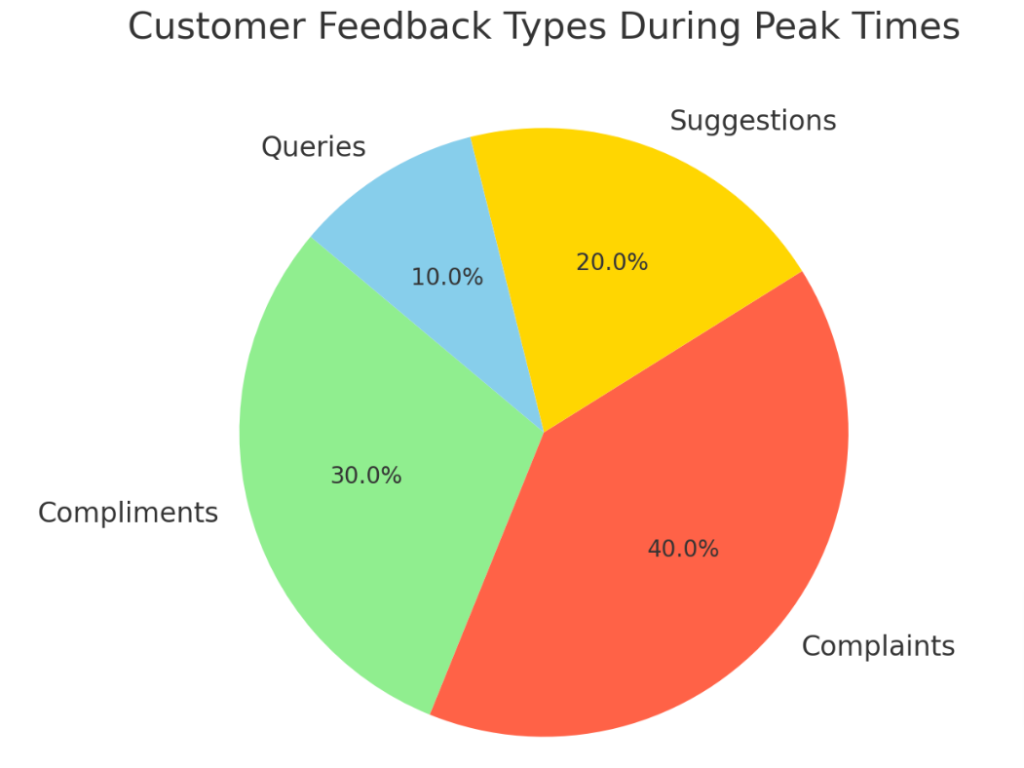Achieving Excellence During High Demand: Key Practices for Service Consistency
Everyone knows the stress of keeping customers happy when things get busy. During peak times, businesses often see their service standards tested to the limit. This article offers practical tips and strategies to ensure your service stays top-notch, even under pressure.
Keep reading for invaluable insights!
Key Takeaways
- Effective planning is crucial for handling the surge in customer inquiries during peak times; businesses need to forecast demand and allocate resources accordingly.
- Automation tools can streamline processes, minimizing mistakes and ensuring customers receive timely support even when service teams are under pressure.
- Clear communication with both team members and customers helps manage expectations and keeps everyone informed, reducing frustration during busy periods.
- Empowering staff with decision – making authority and providing necessary training allows them to respond confidently to customer needs, enhancing the overall service experience.
- Regular monitoring of key performance indicators such as response times and customer feedback is essential for continuous improvement of service standards.
Challenges of Maintaining High Service Standards During Peak Times
During peak times, customer inquiries increase and there’s a greater potential for mistakes while struggling to keep up with demand.
Increased customer inquiries
Handling a surge in customer inquiries can test the limits of even the most efficient customer service teams. As more people reach out for assistance, it’s crucial to manage these interactions swiftly and effectively to maintain high service standards.
Quick response times and accurate information become key priorities. In peak seasons or busy times, every call, email, or chat represents an opportunity to solidify a positive customer experience. Service team management becomes critical as volume increases; ensuring that each representative has the tools and knowledge they need to address concerns elevates the service quality dramatically.
Efficient workforce management is essential in distributing this increased load evenly among staff members so no single person feels overwhelmed and every inquiry receives prompt attention.
Greater potential for mistakes
As service teams juggle a surge in customer inquiries, the pressure can mount, inadvertently raising the odds of errors. Mistakes may range from minor oversights to significant mishaps that can impact customer satisfaction.
During these peak hours, even the most experienced staff members are susceptible to slip-ups due to the sheer volume of tasks and the fast-paced environment.
Ensuring operational excellence becomes challenging as each mistake could potentially diminish service quality. The goal is always to provide a consistent service experience but, under high-stress conditions, maintaining those standards requires extra vigilance.
It’s crucial for customer service teams to stay focused and double-check their work to avoid errors that could harm long-standing relationships with customers or dent new ones just beginning to take shape.
Struggles to keep up with demand
Peak seasons bring a surge in customer interactions that can overwhelm even the most well-prepared service team. Staff members find themselves juggling numerous tasks, from handling customer inquiries to resolving issues, often leading to longer wait times and hurried service.
High volume periods test the limits of efficiency and challenge teams to maintain consistent service quality despite the rush.
Maintaining high service standards becomes difficult as every phone call, email, or chat request stretches resources thin. The workforce management strategies usually in place may falter under pressure as more customers demand immediate attention.
This situation demands innovative solutions for demand management to ensure that service levels do not drop and operational excellence remains intact during these busy times.
Strategies for Maintaining High Service Standards
Plan ahead by forecasting peak times and allocating resources accordingly. Communicate clearly with customers about expected wait times or any potential delays. Automate and streamline processes to handle the increased volume of inquiries efficiently.
Empower and support staff to make quick decisions and provide top-notch service. Monitor and evaluate operations in real-time to address any issues promptly.

Plan ahead
Before the peak season hits, it’s vital to plan ahead and anticipate the increased demand. By forecasting customer needs and predicting busy periods, you can develop a strategy to ensure seamless service delivery.
This may involve adjusting staffing levels, optimizing workflows, or implementing technology solutions to support your team during high-volume times.
In ensuring excellence during peak hours, planning ahead enables proactive problem-solving and prevents operational bottlenecks that could impact service quality. Taking this step allows for a more efficient allocation of resources which supports consistent service experience and customer satisfaction levels.
Communicate clearly
To maintain high service standards during peak times, clear communication is essential to ensure that all team members are aligned and informed. By clearly outlining expectations, procedures, and any changes in protocols or priorities, the entire customer service team can work cohesively towards delivering consistent and quality service.
Clear communication also ensures that customers are kept well-informed about any delays or issues, managing their expectations effectively and reducing frustration.
Customers appreciate being kept in the loop and understanding what may be causing delays or impacting service levels. When a customer feels acknowledged through clear communication, they are more likely to remain patient during busy periods.
Automate and streamline
Automate and streamline customer service processes to ensure efficiency during peak times. Utilize automation tools for repetitive tasks, such as responding to common inquiries or processing routine requests.
By streamlining workflows, you can allocate resources more effectively, optimizing the customer service team’s productivity.
Implementing automated systems for managing high call volumes and inquiries minimizes the risk of errors and delays. This ensures that customers receive consistent and timely support, contributing to a positive overall service experience.
Empower and support staff
To effectively maintain high service standards during peak times, it’s essential to empower and support staff. Providing comprehensive training and clear guidelines equips employees to handle increased customer inquiries with confidence.
Encouraging open communication and feedback channels also fosters a supportive work environment, enabling the team to navigate busy periods more effectively.
Empowering staff involves delegating authority to make decisions in line with company standards. This could mean providing frontline workers with autonomy to resolve customer issues swiftly, without needing approval at every step of the process.
Monitor and evaluate operations
Monitor and evaluate operations to identify bottlenecks or inefficiencies in the customer service workflow. Analyze key metrics such as response times, resolution rates, and customer feedback to pinpoint areas for improvement.
Use this data to make informed decisions about staffing levels, training needs, and process enhancements, ensuring that the team can continually deliver high-quality service even during peak periods.
Keep a close eye on operations by implementing real-time reporting tools and regular performance reviews with the customer service team. Continuously track progress against established service standards using customer satisfaction surveys and operational KPIs.
Benefits of Maintaining High Service Standards
– Positive customer experience and competitive advantage are just some of the benefits that come from maintaining high service standards during peak times. These standards also provide measurable milestones for customer satisfaction, ultimately leading to improved business outcomes.
Positive customer experience
Customers who receive high-quality service during peak times are more likely to have a positive experience. This can lead to increased loyalty, positive word-of-mouth referrals, and repeat business.
Providing efficient and effective customer service during busy periods demonstrates a commitment to meeting customer needs and sets the stage for building strong, lasting relationships with your client base.
Maintaining high service standards in peak times not only ensures that customers are satisfied but also contributes to the overall success of the business. With streamlined processes and empowered staff members, businesses can create an environment where customers feel valued and well taken care of, ultimately leading to positive customer experiences.
Competitive advantage
Delivering consistent and high-quality service during peak times gives businesses a competitive advantage. By efficiently managing customer inquiries and maintaining service standards, companies can set themselves apart from competitors.
Streamlining operations and ensuring timely responses contribute to enhanced customer satisfaction, leading to repeat business and positive word-of-mouth referrals.
Maintaining high service standards in peak times is essential for businesses looking to stay ahead of the competition. However, it’s also crucial to measure performance in order to continually improve.
Measurable milestones for customer satisfaction
To measure customer satisfaction, track response times, resolution rates, and feedback scores. These metrics provide tangible evidence of service quality. Implementing a customer relationship management (CRM) system can help gather essential data to assess satisfaction levels consistently.
Additionally, conducting regular surveys or feedback forms allows customers to express their opinions directly. Analyzing this input offers insights into areas for improvement and highlights successful strategies.
Consistently monitoring these measurable milestones ensures ongoing adjustments to improve the overall service experience. When attainable goals are set based on these milestones, it becomes easier to gauge progress and maintain high service standards during peak times.
Conclusion
Implementing the strategies discussed can help customer service teams maintain high standards during peak times. Clear communication ensures that everyone is on the same page. Empowering and supporting staff leads to greater efficiency in handling customer inquiries.
Planning ahead allows for better management of the increased demand, leading to a positive customer experience. Monitoring and evaluating operations helps identify areas for improvement, maintaining consistent service quality during busy periods.

